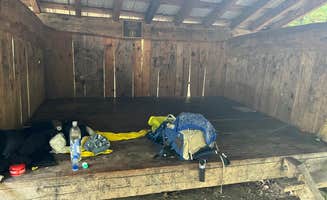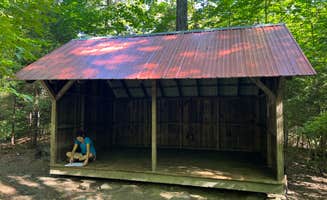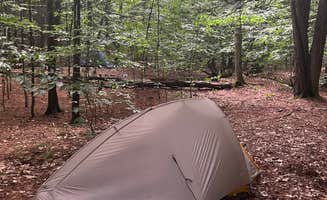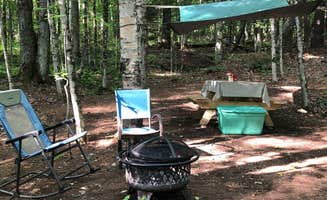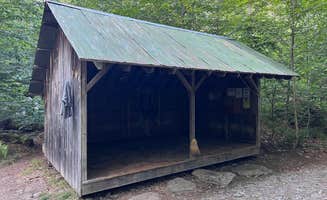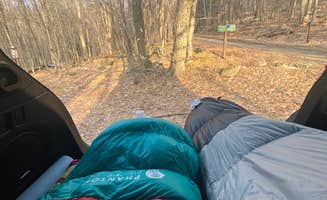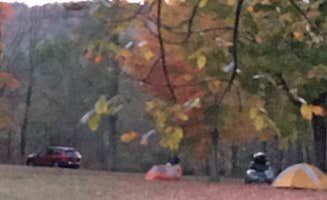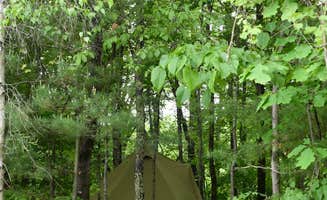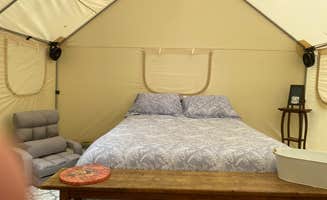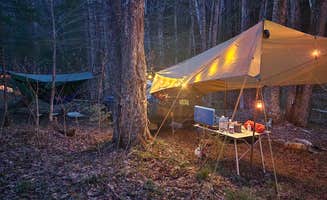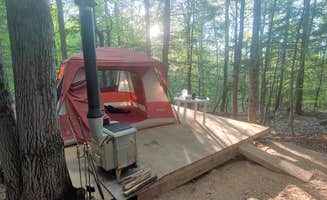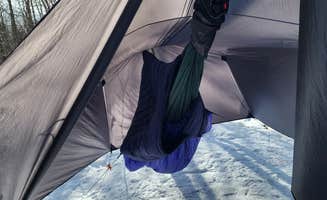Backcountry tent camping along the Appalachian Trail corridor near Plainfield, New Hampshire provides primitive overnight options for hikers traversing this section of the famous footpath. Most sites sit at elevations between 1,000-2,500 feet, with distinct seasonal water availability patterns. Winter camping is possible but requires advanced preparation as most shelters receive no winter maintenance.
What to do
Stream exploration: At Stony Brook Backcountry Shelter, hikers can access a swimming hole where the water is deep enough to "just barely submerge myself to clean off a bit," according to one visitor. The shelter is located on the Vermont side of the AT and features reliable water sources during most seasons.
Summit Mount Cardigan: The climb from Cardigan Campsites offers challenging terrain but rewards hikers with panoramic views. "The climb is challenging but shouldn't take too long. Great fire tower views at the top too!" notes one camper. This established campground provides a strategic base for summit attempts.
Viewpoint hiking: For those seeking scenic outlooks, Moose Mountain Backcountry Shelter provides access to nearby viewpoints. One hiker mentioned the shelter "did stand out with a bench overlooking a clearing in the brush with a view which was a great place to enjoy my freeze dried dinner."
What campers like
Multi-level sleeping options: At Happy Hill Backcountry Shelter on the Vermont side of the AT, campers appreciate the unique double-decker design. One reviewer noted, "The shelter had a ground floor and a loft but each floor could maybe fit 4-5 people comfortably... The loft was nice since folks could decide to sleep up there while others were down below, either cooking, arriving, or departing."
Bear boxes: Some shelters provide secure food storage options. Stony Brook Shelter includes this important amenity, with one hiker noting, "There was also a bear box here, which I hadn't seen at other shelters along the AT in Vermont (heading southbound)."
New privies: Facility quality varies significantly between sites. At Trapper John Backcountry Campground, there is "a standard back country privvy," while Stony Brook features a privvy that "looked brand new and was more spacious than most on the trail."
What you should know
Water reliability: Most sites have seasonal water sources that frequently run dry in late summer. At Thistle Hill Backcountry Shelter, one camper reported finding water "during my stay, though it was right after a smaller storm the previous evening." Monitoring recent weather patterns before your trip helps predict water availability.
Tent site variability: Flat spots for pitching tents vary considerably between locations. Thistle Hill Backcountry Shelter has "smaller spots for tent camping that were somewhat sloped," according to one visitor. Arriving early generally secures better tent locations.
Permit requirements: New Hampshire shelters typically require permits while Vermont shelters do not. Prepare for self-sufficient camping, as one hiker emphasizes at Trapper John: "Note this is a back country shelter along the AT in New Hampshire so it is entirely hike in."
Tips for camping with families
Choose sites with swimming access: During warmer months, shelters near water features provide cooling opportunities. One camper at Stony Brook noted finding "a decent swimming hole" by exploring "a bit offtrail down the brook."
Consider tent space needs: Family groups require more space. Winturri Backcountry Shelter offers "lots of tent camping spots as you worked up the hill perpendicular to the shelter" and "a great amount of tent camping around in spaces with decent privacy."
Plan for variable weather: The area experiences rapid temperature fluctuations, especially at higher elevations. September through October brings freezing nighttime temperatures while maintaining pleasant daytime conditions, requiring layered clothing systems.
Tips from RVers
No direct RV access: The best tent camping near Plainfield, New Hampshire is primarily accessible via hiking trails. RV campers must park at designated trailheads and backpack to sites. Trapper John Backcountry Campground is "entirely hike in" with no vehicle access, typical of all AT shelters in the region.
Use established campgrounds as base camps: For RV campers wanting to explore the AT, establish a base at developed campgrounds in the region, then day hike to backcountry shelters. Most hikers using these shelters are either "doing a week-long section hike of the AT" or shorter overnight trips rather than RV-based camping.


